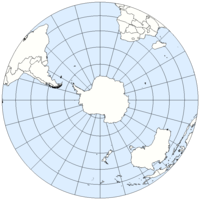
Photo from wikipedia
Abstract. Geomagnetic storms are the most pronounced phenomenon of space weather. When studying ionospheric response to a storm of 15 August 2015, an unexpected phenomenon was observed at higher middle latitudes of… Click to show full abstract
Abstract. Geomagnetic storms are the most pronounced phenomenon of space weather. When studying ionospheric response to a storm of 15 August 2015, an unexpected phenomenon was observed at higher middle latitudes of the Southern Hemisphere. This phenomenon was a localized total electron content (TEC) enhancement (LTE) in the form of two separated plumes, which peaked southward of South Africa. The plumes were first observed at 05:00 UT near the southwestern coast of Australia. The southern plume was associated with local time slightly after noontime (1–2 h after local noon). The plumes moved with the Sun. They peaked near 13:00 UT southward of South Africa. The southern plume kept constant geomagnetic latitude (63–64° S); it persisted for about 10 h, whereas the northern plume persisted for about 2 h more. Both plumes disappeared over the South Atlantic Ocean. No similar LTE event was observed during the prolonged solar activity minimum period of 2006–2009. In 2012–2016 we detected altogether 26 LTEs and all of them were associated with the southward excursion of Bz. The negative Bz excursion is a necessary but not sufficient condition for the LTE occurrence as during some geomagnetic storms associated with negative Bz excursions the LTE events did not appear.
Journal Title: Annales Geophysicae
Year Published: 2018
Link to full text (if available)
Share on Social Media: Sign Up to like & get
recommendations!